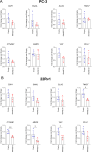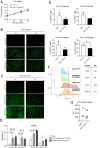The human RNASET2 alarmin-like molecule differentially affects prostate cancer cells behavior in both cell autonomous and non-cell autonomous manners
- PMID: 40389981
- PMCID: PMC12090474
- DOI: 10.1186/s12967-025-06540-0
The human RNASET2 alarmin-like molecule differentially affects prostate cancer cells behavior in both cell autonomous and non-cell autonomous manners
Abstract
The identification of molecules that make cancer cells detectable by the immune system represents a major challenge in tumor immunology. Alarmins, endogenous, stress-induced molecules, serve as early warning signals triggering immune responses. The human RNASET2 protein has demonstrated both oncosuppressive and immunoregulatory functions across various cancer types, yet its role as an oncosuppressor or alarmin-like molecule in prostate cancer (PCa) is unexplored. Here, we investigated the effects of the human RNASET2 alarmin in two different human PCa cell lines focusing on cell proliferation, colony formation, adhesion, migration rates, and release of soluble immune-modulatory factors. In vivo studies were also carried out on nude mice to assess the immune regulatory impact. Our findings indicate that RNASET2 overexpression reduced cell proliferation and colony formation in 22Rv1 cells, through downregulation of cyclin D1. RNASET2 overexpression in 22Rv1 cells was also associated with decreased levels of TWIST, CTNNB1, YAP, and MMP-9. By contrast, PC-3 cells were largely unresponsive to RNASET2. RNASET2 overexpression also promoted the release of soluble factors related to monocyte/macrophage recruitment/activation and cytokines/chemokines, linked to immune cell-mediated anti-tumor responses. This effect was more pronounced in RNASET2-overexpressing 22Rv1 cells and involved both innate (NK cells, dendritic cells) and adaptive (T cells) immune activation, compared to PC-3 cells. RNASET2 overexpression also affected the cytoskeletal organization in both PCa models. RNASET2 overexpression in vivo induced a shift toward M1-like macrophage polarization pattern, while decreasing the M2-like polarization in mice challenged with 22Rv1 cells, indicating a potential tumor-suppressive role in PCa. Finally, silencing of RNASET2 in THP-1 macrophages unveiled their phagocytic activities against PCa cells. Our findings underscore the RNASET2's dual functionality, acting through both cell-autonomous and non-cell autonomous mechanisms in PCa in vitro and in vivo models and suggest its potential as a therapeutic target in a subset of PCa.
Keywords: Alarmins; Macrophages; Oncosuppressors; Prostate cancer; RNASET2.
© 2025. The Author(s).
Conflict of interest statement
Declarations. Institutional review board statement: Subjects enrolled in the study were recruited within the protocol No. 463.2021, approved by the institutional review board IRCCS MultiMedica Ethics Committees, and adhered to the principles outlined in the Helsinki Declaration of 1975, revised in 2013. Informed consent statement: The study protocol (No. 463.2021) received approval from the institutional review board ethics committees and adhered to the principles outlined in the Helsinki Declaration of 1975, revised in 2013. Informed consent was obtained from all participants, in compliance with the Helsinki Declaration of 1975, revised in 2013. Conflict of interest: The authors declare no conflict of interest.
Figures








Similar articles
-
Prognostic and immunological implications of cathepsin Z overexpression in prostate cancer.Front Immunol. 2025 Jun 11;16:1618487. doi: 10.3389/fimmu.2025.1618487. eCollection 2025. Front Immunol. 2025. PMID: 40568593 Free PMC article.
-
SREBF1-mediated SND1 transcriptional activation promotes prostate cancer progression via MTDH interaction through the SESN2/AMPK/mTOR axis.J Transl Med. 2025 Aug 7;23(1):885. doi: 10.1186/s12967-025-06762-2. J Transl Med. 2025. PMID: 40775338 Free PMC article.
-
TYROBP overexpression alters macrophage phenotype and enhances pancreatic cancer stemness through STAT3 and PKM2 signaling.Cell Signal. 2025 Oct;134:111949. doi: 10.1016/j.cellsig.2025.111949. Epub 2025 Jun 18. Cell Signal. 2025. PMID: 40553966
-
Systemic treatments for metastatic cutaneous melanoma.Cochrane Database Syst Rev. 2018 Feb 6;2(2):CD011123. doi: 10.1002/14651858.CD011123.pub2. Cochrane Database Syst Rev. 2018. PMID: 29405038 Free PMC article.
-
Systemic pharmacological treatments for chronic plaque psoriasis: a network meta-analysis.Cochrane Database Syst Rev. 2021 Apr 19;4(4):CD011535. doi: 10.1002/14651858.CD011535.pub4. Cochrane Database Syst Rev. 2021. Update in: Cochrane Database Syst Rev. 2022 May 23;5:CD011535. doi: 10.1002/14651858.CD011535.pub5. PMID: 33871055 Free PMC article. Updated.
References
MeSH terms
Grants and funding
LinkOut - more resources
Full Text Sources
Medical
Research Materials
Miscellaneous

